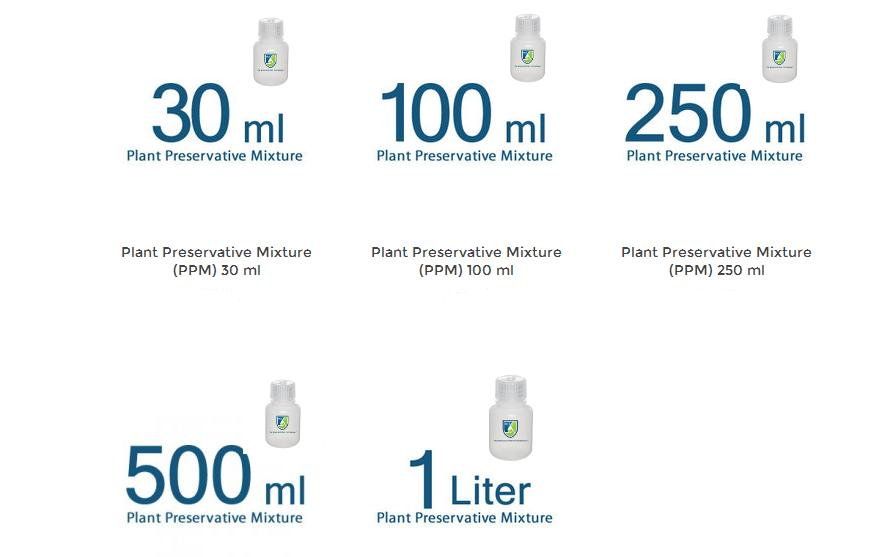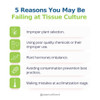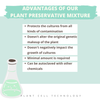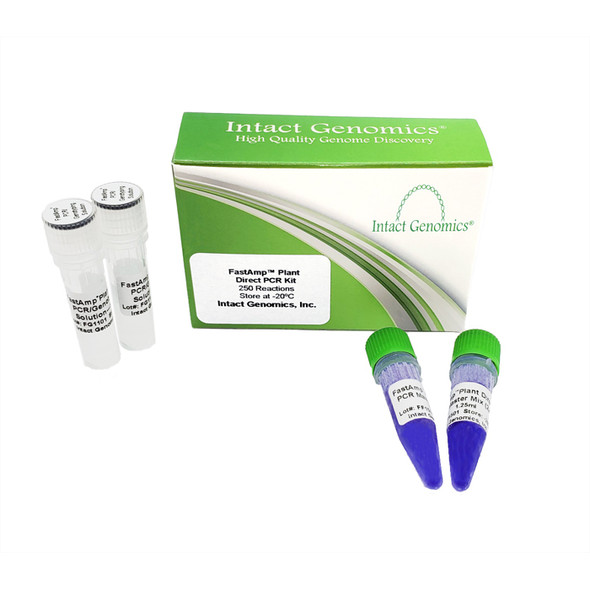Plant Preservative Mixture (PPM)
- SKU:
- PCT
- Availability:
- next day delivery PPM - Plant Preservative Mixture
Description
PPM - Plant Preservative Mixture
The Plant Preservative Mixture (PPM™), developed by Plant Cell Technologies, is a broad-spectrum biocide specifically designed to combat microbial contamination in in vitro plant tissue cultures. As a phytosanitary agent, PPM™ offers a superior alternative to conventional antibiotics by preventing contamination without disrupting plant cellular processes. This makes it a highly effective and economical solution for maintaining aseptic conditions during critical stages of plant tissue culture.

Mechanism of Action
PPM™ operates by inhibiting multiple key enzymes within microbial cells, particularly those involved in the Krebs cycle and electron transport chain. These pathways are crucial for microbial energy production and metabolic processes. By disrupting these systems, PPM™ effectively suppresses microbial growth, including bacteria and fungi, while leaving plant cells unharmed. This multi-enzyme targeting strategy significantly reduces the risk of developing resistant microbial strains, which is a common issue associated with prolonged antibiotic use.

Thermal Stability and Compatibility with Culture Media
One of the standout features of PPM™ is its exceptional thermal stability. The product can withstand autoclaving at 121°C for 20 minutes without losing its efficacy, making it easy to incorporate into culture media during preparation. PPM™ is compatible with a wide range of media formulations, such as the widely used Murashige and Skoog (MS) medium. It can be used alongside various plant growth regulators, including kinetin and indole-3-butyric acid (IBA), to support processes like callus induction and microshoot proliferation.
Efficacy in Contamination Control
PPM™ provides robust protection against both exogenous contamination (airborne, waterborne, or human-introduced) and endogenous contamination (microbes within plant tissues). It inhibits bacterial and fungal spore germination, ensuring effective contamination control during critical phases such as seed germination, callus proliferation, and microshoot regeneration. Unlike traditional antibiotics, which may target only specific bacteria or fungi, PPM™ offers comprehensive protection against a wide spectrum of contaminants, including gram-positive and gram-negative bacteria, yeasts, and molds.

Non-Inhibitory Effects on Plant Growth and Development
Research confirms that PPM™ does not interfere with plant growth when used at optimal concentrations. Studies, such as those conducted on cauliflower (Brassica oleracea var. botrytis) microshoots, have shown that a concentration of 0.5 mL/L in MS medium supplemented with 2 mg/L kinetin and 1 mg/L IBA effectively controls contamination while promoting plant development. However, higher concentrations of PPM™ may negatively impact shoot proliferation, highlighting the importance of optimizing dosage based on specific plant tissue culture conditions.
In addition to its use in media, PPM™ has also been successfully incorporated into artificial seed production. For example, cauliflower microshoots encapsulated in sodium alginate and germinated in media containing PPM™ showed enhanced conversion rates and plantlet viability, demonstrating its effectiveness in maintaining aseptic conditions and improving plantlet growth.
Cost-Effectiveness and Commercial Applications
PPM™ is particularly beneficial for large-scale commercial plant tissue culture laboratories, where contamination can lead to significant productivity losses. By integrating PPM™ into routine culture protocols, laboratories can reduce their reliance on costly antibiotics. Given its affordability and efficacy, PPM™ is an attractive option for operations that require stringent contamination control for economic sustainability.
Recommended Usage and Protocols
PPM™ is recommended at concentrations ranging from 0.05 to 0.5 mL/L, depending on the type of tissue and the stage of the culture process. In liquid culture systems, contamination levels should be monitored regularly, with PPM™ concentrations adjusted accordingly. The product is non-toxic to plant cells and can be added to all culture media, providing continuous protection throughout the culture cycle.
Research and Patent Protection
PPM™'s innovative formulation and application are protected under US Patent No. 5,750,402, with additional patents in Canada, New Zealand, Australia, and the European Community, among other regions. Developed by Dr. Assaf Guri, a leading expert in applied genetics and plant breeding, PPM™ is the result of extensive research conducted at the Volcani Agricultural Research Center and Michigan State University. Today, it is widely used in tissue culture laboratories across the globe.
Availability and Distribution
PPM™ is available in a variety of packaging sizes, including 30 mL, 100 mL, 250 mL, 500 mL, and 1 L, to accommodate different laboratory needs. Gentaur Molecular Products is the official distributor for France and Europe. Orders outside of Metropolitan France can be placed through the head office in Belgium. Bulk discounts are available for orders exceeding two bottles, and certificates of analysis can be provided upon request.
| Reference | Condtionnement | Unit Price HT |
| PCT01 | 30 mL (test) |
45,49 € |
| PCT02 | 100 mL | 127,39 € |
| PCT03 | 250 mL | 326,29 € |
| PCT04 | 500 mL | 519,99 € |
| PCT05 | 1 L | 1.039,99 € |

Product Information Summary
- Product Name: Plant Preservative Mixture (PPM™)
- Use: Preservative for plant tissue culture media
- pH: 5 - 7
- Thermal Stability: Autoclavable and heat-stable
- Solubility: Completely soluble in water
- Recommended Concentration: 0.05 to 0.5 mL/L
- Applications:
- Controls microbial contamination in culture media
- Ensures aseptic conditions for seed germination, callus proliferation, and plantlet regeneration
- Promotes successful artificial seed production
PPM™ has revolutionized contamination control in plant tissue culture laboratories. Its ability to maintain aseptic conditions without affecting plant cellular processes makes it an invaluable tool for researchers and commercial-scale operations. With its affordability, broad-spectrum activity, and long-term effectiveness, PPM™ continues to be the preferred solution for contamination control in plant tissue culture.
10 Reviews
-
A Must-Have for Plant Tissue Culture!
As someone deeply involved in plant tissue culture, I can confidently say that the Plant Preservative Mixture is an absolute necessity.
-
Efficiency
This product has been a game-changer for my tissue culture work. The reduction in contamination has allowed me to focus more on the growth and development of my plants rather than constantly battling infections. I highly recommend PPM to anyone involved in plant tissue culture, especially if contamination has been a persistent issue.
-
Best meristem propagation medium for plant stems.
Meristemic propagation of plants Institute.
-
Plant Preservative Mixture
Plant Preservative Mixture (PPM) is an effective solution for preventing microbial contamination in plant tissue cultures. It protects against bacteria, fungi, and yeast without harming plant cells, making it ideal for research and cultivation. The product is easy to use by simply adding it to the culture medium, offering convenience and reliability. PPM ensures a sterile environment, promoting healthy plant growth.
-
Effective !!
This plant tissue culture anti-contamination mix offers a reliable solution for preventing microbial growth.minimizes contamination risks without compromising seed germination or callus development. A valuable addition to any plant scientist's toolkit.
-
Active ingredients
The active ingredients are 5-chloro-2-methyl3(2H)-isothiazolone and 2-methyl-3(2H)- isothiazolone. That is why for callus in vitro culture in labs the PPM is effective against bacteria and fungi, is heat stable, and can be autoclaved. You only use some microliters per callus stem in your laboratory.
-
shipping
Genprice's shipping of the Plant Preservative Mixture (PPM) exceeded my expectations. The package arrived promptly and was securely packaged to prevent any damage during transit. Overall, I am highly satisfied with the shipping service provided by Genprice and would not hesitate to recommend them to others seeking reliable and efficient shipping for their products.
-
Schnelle Lieferung
War am nächsten Tag in Skopje, Macedonia.
-
easy use
The PPM does not inhibit the in vitro seed germination or the good callus proliferation and callus regeneration. PPM prevents the germination of both bacteria and fungi spores.
-
Easy
We bought PPM PLANT PRESERVATIVE MIXTURE from Gentaur Maxanim the distributor of Plant Cell Technology, Inc. in Europe. They told us that Plant Cell Technology has developed this heat stable preservative biocide, to eliminate all microbial contamination in plant tissue culture. It is indead an very effective plant medium decontaminantion agent but it does not impair in vitro seed germination, callus proliferation and callus regeneration. So despite the most stringent use of sterile techniques, the contamination of plant cell and plant tissue cultures remained a persistent problem for us that resulted always in losses ranging from small number of cultures to the loss of whole batches. Thanks to PPM we could prevent the germination of both bacteria and fungi spores. It is heat stable and therefore we could autoclaved it with the PPM. Our plant tissue culture mediais now expensive than the harmful antibiotics we used before! So PPM is designed to inhibit airborne contamination, waterborne contamination and contamination introduced from human contact, but for us it reduces endogenous internal contamination. PPM tissue culture protocol we use: 1. Media containing PPM can be dispensed outside the laminar flow hood (LFH) exposed to the ambient air. The plates should be covered soon after agar solidification. In the event that media dispensing is done by a pump, we recommend passing autoclaved hot water through the hoses prior to and after media dispensing. 2. Heat sensitive or heat stable liquid media containing PPM does not need to be sterilized by Millipore filters or autoclaved provided that it will be stored in sterile containers and that the stock solutions are not contaminated. In rich media containing 200 mg/liter or more of amino acids or proteins, it is recommended to filter the media with the PPM. 3. If working in the LFH the utensils (forceps or scalpels) do not need to be flamed. They should be periodically dipped in 70% alcohol. The LFH does not need to be certified and the work can be done as well outside the LFH on a clean surface for a period not exceeding 1 hour. 4. PPM™ is an acidic liquid solution (pH 3.8). PPM™ should be stored at 4°C. (see Safety Information below). The recommended dose is 0.5 – 2.0 ml of PPM™ per liter of medium is added to the medium before or after autoclavation to prevent airborne and endogenous contamination at low inoculum densities. Higher doses are required to treat endogenous contamination or to obtain Agrobacteria free plant material. 5. PPM™ is less effective when exposed to high density of bacteria or fungi spores found on seed’s coat. For in vitro germination, seeds should be conventionally surface sterilized with bleach. Therefore, in the presence of PPM™ (in the germination medium), the seeds can be rinsed under tap water in a non-sterile strainer and left to dry preferably in the LFH. If the utensil ends have touched active bacteria, fungi culture or otherwise suspected of being contaminated, they should be sterilized by autoclaving or by use of an electric heating element. 6. General dosage levels. With the exception of endogenous contamination, the recommended dose range is 0,05% – 0,2%. For callus proliferation, organogenesis and embryogenesis, the recommended range is 0,05%- 0,075%. Add PPM™ to medium pre or post autoclavation to prevent airborne contamination and endogenous contamination at low inoculum densities or slow growing bacteria. To eliminate higher endogenous contamination densities, higher doses of PPM™ are needed (see paragraph 7). 7. Endogenous Contamination: (a) For seeds: stir non-sterilized seeds for 8-12 hours in 2% PPM™ solution (v/v) supplemented with full strength basal salts of your routinely used medium and don’t add Tween 20 or pH this solution. Subsequently, without rinsing, transfer to germination medium supplemented with 0,05% – 0,1% PPM™ for herbaceous plants and 0,2% PPM™ for woody plants. Hard coated seeds such as Asparagus, Lupine, Ornamental Palm, Rose etc. should be soaked in water for 2-4 hours prior to the sterilization with PPM. (b) For explants: gently shake / stir 1 cm long explants (or shorter) routinely in bleach solution to remove surface contamination. Rinse with water (can be done under non sterile conditions) and shake / stir for 12 hours in 4-5% v/v PPM™ solution supplemented as above with full MS (or 2X) strength basal salts without pH ing and without Tween 20. Without rinsing, insert into a medium supplemented with 0,05% – 0,1% PPM™ for herbaceous plants and 0,2% for woody plants If possible, collect woody plant material after dormancy is broken. This will substantially decrease contamination. (c) For tubers: shake /stir the entire tuber routinely in bleach solution. Rinse with water (can be done under non sterile conditions) and slice the tuber (bulb or scale) into thin slices. Shake / stir for 12 – 24 hours in 4-5% PPM™ solution supplemented with full strength (or 2X) basal salts without pH ing and add Tween 20. Without rinsing insert into a medium supplemented with 0,1-0,2% PPM™. 8. In cases that the above protocols don’t yield satisfied results (especially with thick explants or highly infested explants and seeds), we recommend the followings: (a) Shake / stir the explants (or seeds) in water (does not have to be sterile), 1 hour for soft tissues and 2 hours for hard tissues (b) Shake / stir the explants in 50% PPM™ (dilute with sterile water) supplemented with 2X full strength MS basal salts without pH ing and Tween 20 for 10 – 15 minutes. (c) Without rinsing, insert the explants in to the medium. In fungal contamination, the addition of PPM™ to the medium is optional. However in bacterial contamination or mixed contamination, the addition of 0,05-0,2% PPM™ to the medium in the first month is essential. Don’t discard highly oxidized explants, approximately 50% will recover after 4-6 weeks. 9. To decontaminate “in culture” contaminated explants or plants (rescue treatment), the cultures shouldn’t be left visibly contaminated longer than one week. Clean the material mechanically with the aid of a soft brush under stream of tap water. Shale / stir in a 50% PPM™ solution (diluted with sterile water) for 5 – 15 minutes. In bacterial contamination or mixed contamination, we recommend to lower the pH to the range of 2.8 – 3.2 by mixing 1:1 full strength 100%PPM™ with 0,6 g/l citric acid solution (use sterile water). Without rinsing insert into a medium with 0,05-0,2% PPM™ for at least one month and keep the culture away from high light intensities for the first 10 days. As mentioned above, don’t discard oxidized explants. Wait 4 – 6 weeks. In some cases the fungal or the bacterial spores are located deep within the explants beyond PPM™ reach. In those cases after the water soaking period, slice the explants along and then stir / shake in 50% PPM™ for 10 – 15 minutes.
































